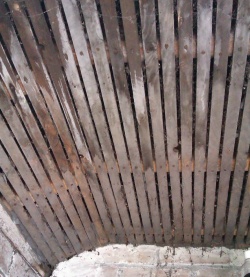Difference between revisions of "Lath & plaster ceiling"
(→Properties: nm) |
(→Materials: m linkfix) |
||
| Line 34: | Line 34: | ||
==Materials== | ==Materials== | ||
| − | Galvanised steel [[EML]] is far faster to fit than wood strips, so tends to be chosen for new work. Where the same construction is required, oak and hazel are common lath materials. Bamboo is occasionally used for laths, its supply in roll form for fencing makes fitting it relatively quick. | + | Galvanised steel [[Roll_Materials#EML_for_Wall_reinforcement|EML]] is far faster to fit than wood strips, so tends to be chosen for new work. Where the same construction is required, oak and hazel are common lath materials. Bamboo is occasionally used for laths, its supply in roll form for fencing makes fitting it relatively quick. |
For a small minority of [[Period Property|listed buildings]], it has been required to use the same type of animal hair as the original L&P. | For a small minority of [[Period Property|listed buildings]], it has been required to use the same type of animal hair as the original L&P. | ||
| − | Hair should be [[Cleaning|cleaned]] (degreased) & beaten. | + | Hair should be [[Cleaning|cleaned]] (degreased) & beaten. |
| − | |||
==See also== | ==See also== | ||
Revision as of 21:20, 7 October 2014
Lath & plaster walls & ceilings are often found in old houses. They consist of 2 parts:
- Laths, thin wood strips nailed to the joists or uprights, with gaps between them
- Plaster, pressed on so it squeezes through the gaps and grips the laths
Sometimes animal hair reinforces the plaster.
Historic L&P ceilings use wood laths & lime plaster. Modern L&P is seen occasionally, typically with galvanised EML and gypsum plaster.
Lathes are never incorporated into ceilings, they're far too heavy!
Picture: laths before plastering
Properties
Old L&P ceilings are much thicker than plasterboard, giving much better noise blocking. The thicker plaster also improves fire resistance some.
Historic L&P is sometimes in poor condition. Falling lumps sometimes exceed 10kg and contain grit.
Repair
Where its wished to retain an L&P ceiling that's beginning to break, screws & penny washers can be placed into joists to hold pieces up. Don't attempt to screw into lath, its a futile exercise. Pouring diluted PVA or fresh plaster onto the topside of the ceiling is done sometimes to stabilise old ceilings. Missing patches are fairly straightforward to patch with plaster. Once stabilised, a damaged ceiling can be plaster skimmed, or in some cases patch filled.
Removal
When L&P begins to collapse its usually removed. Though simple to do (whack it), the normal result is filth so severe that it ruins the finish on everything it touches. Once gone, either the numerous nails are removed & new plasterboard is applied, or loose laths are refixed, broken laths replaced and the whole wet plastered.
Replacing L&P with plasterboard significantly increases noise transmission from room to room.
A theoretical risk of anthrax from some old L&P has been proposed, but there have been zero cases contracted from working on L&P in the last century.
Overboarding
Putting plasterboard over (or technically under) old L&P is another repair option. The sound retaining property of L&P is retained, and the filth from hell is avoided. But locating joists for the new screws isn't as simple. Options include:
- If you can lift a few floorboards above, drilling some tiny marker holes next to joists can be a real help; joist positions can then be pencilled onto the ceiling or the top of the walls.
- A very strong neodymium magnet can detect the nails in the joists.
Materials
Galvanised steel EML is far faster to fit than wood strips, so tends to be chosen for new work. Where the same construction is required, oak and hazel are common lath materials. Bamboo is occasionally used for laths, its supply in roll form for fencing makes fitting it relatively quick.
For a small minority of listed buildings, it has been required to use the same type of animal hair as the original L&P.
Hair should be cleaned (degreased) & beaten.
